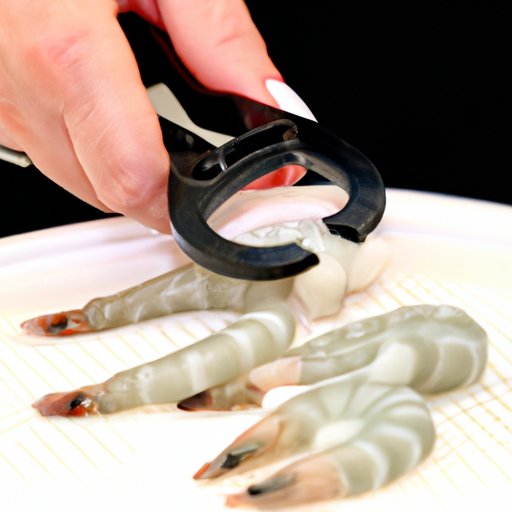Introduction
Shrimp is a delicacy loved by many people around the world. However, preparing shrimp can be a daunting task, especially if you do not know how to devein shrimp properly. Deveining shrimp is a critical step in preparing shrimp, and it involves removing the digestive tract or vein from the back of the shrimp. In this article, we will provide a comprehensive guide on how to devein shrimp.
Step-by-step guide
Deveining shrimp can be broken down into a few simple steps:
- Remove the shell from the shrimp but leave the tail on.
- Locate the vein, which is a thin, dark line that runs along the shrimp’s back.
- Use a small knife or a deveining tool to make a shallow cut along the vein.
- Use a toothpick or the tip of the knife to pull the vein out of the shrimp’s body, starting from the head end and working down towards the tail.
- Rinse the shrimp under cold water to remove any remaining debris.
It is essential to take care not to cut too deep when removing the vein, as this may damage the shrimp. Additionally, it is easier to remove the vein when the shrimp is still raw, so make sure to devein your shrimp before cooking. To help clarify the process further, refer to the images below:

Following these steps will ensure that you have deveined your shrimp correctly and effectively.
Video tutorial
In addition to the written guide, we’ve provided a video tutorial to help you understand the deveining process better:
This video covers the entire process of deveining shrimp, from start to finish. Take a minute to watch the tutorial to get a better understanding.
Comparative Analysis
There are two primary methods of deveining shrimp: using a knife or using a deveining tool.
Using a knife involves making a shallow cut along the shrimp’s back to expose the vein, then using the tip of the knife to remove it. This method requires a certain level of skill to avoid damaging the shrimp or leaving the vein behind.
Using a deveining tool, on the other hand, is easier and safer. A deveining tool is a specialized tool that is used specifically for deveining shrimp. Simply insert the tool into the shrimp’s back, then pull it out along with the vein. Deveining tools come in different sizes, to accommodate different sizes of shrimp.
When it comes to leaving the tail on versus removing it before deveining, it is mostly a matter of preference. Leaving the tail on makes for more attractive presentation while removing the tail makes for easier handling during eating.
Health benefits
While you may be tempted to skip the deveining process for convenience, it is important to note that undeveined shrimp can pose significant health risks. The vein in the shrimp is the digestive tract, and it can contain toxins and bacteria that are harmful to human health.
Consuming undeveined shrimp can lead to food poisoning, diarrhea, and stomach cramps. In some cases, it can even lead to severe illness. Removing the vein ensures that the shrimp is clean and safe to eat.
Tips and tricks
To make the deveining process more efficient, here are some tips:
- Use a sharp knife or deveining tool to make the process easier and faster.
- Devein the shrimp while it’s still raw, to avoid damaging it.
- Use cold water to rinse the shrimp after deveining, to remove any remaining debris or particles.
- Keep the shrimp nestled in ice while working to prevent them from slipping around the work surface.
Recipe suggestions
Deveined shrimp is a versatile ingredient that can be used in many dishes. Here are some recipe suggestions:
- Garlic butter shrimp scampi over linguine pasta
- Summer shrimp and avocado salad
- Shrimp and grits with a Creole spice twist
- Shrimp fajita wraps with guacamole and salsa
- Classic shrimp cocktail with spicy horseradish sauce
Conclusion
Deveining shrimp is an essential skill for anyone who wants to enjoy shrimp safely and deliciously. From following the step-by-step guide, comparing different methods, learning about health benefits, and trying out a few extra tips and tricks, now you should be ready to tackle deveining shrimp. Don’t let the process intimidate you – once you get the hang of it, it can be an efficient and quick process.
